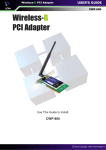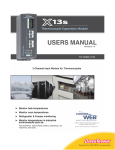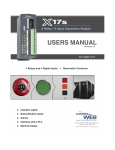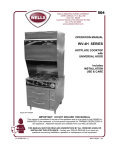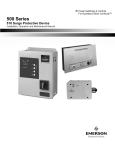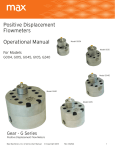Download CNET Wireless-G CardBus Adapter CWC-800 Specifications
Transcript
Wireless-G CardBus Adapter Use This Guide to Install: CWC-800 Table of Contents Chapter 1: Introduction The Smart Wireless-G CardBus Adapter Features Chapter 2: Planning Your Wireless Network Network Topology Ad-Hoc versus Infrastructure Mode Chapter 3: Getting to Know Your CNet Smart Wireless-G CardBus Adapter Chapter 4: Installing Driver, Configuration Utility and Hardware for Windows 98SE/ME/2000/XP Driver Installation for Windows 98SE/ME/2000/XP Inserting the Adapter Chapter 5: Using the WLAN Monitor for Windows 98SE/ME/2000/XP Overview Accessing the WLAN Monitor Link Information Available Network Profiles About Creating a New Profile Appendix A: Troubleshooting Appendix B: Application & Specifications Application Specifications Chapter 1: Introduction The Wireless-G Notebook Adapter: The CNet Smart Wireless-G CardBus Adapter installs in most notebooks and lets you put your computer almost anywhere in the building, without the cost and hassle of running network cables. Now you don't have to drill holes in your walls and climb through the attic or cellar to get connected to the network. Once you're connected, you can keep in touch with your e-mail, access the Internet, use instant messaging to chat with friends, and share files and other resources such as printers and network storage with other computers on the network. The CNet Smart Wireless-G CardBus Adapter connects you with Wireless-G networks at an incredible rate of 54Mbps! And for added versatility, it can also interoperate with all the 11Mbps Wireless-B (802.11b) products found in homes, businesses, and public wireless hotspots around the country. And in either mode, your wireless communications are protected by up to 128-bit encryption, so your data stays secured. So don't hassle with running cables through your house - get your Notebook connected the easy way with the CNet Smart Wireless-G CardBus Adapter. Features: • Investment Protection: 5 Times Faster and Interoperate with Existing Wireless-B Equipment Seamlessly • 40/64/128 bit WEP and Advanced 256-bit WPA (Wi-Fi Protected Access) Encryption Provides Maximum Wireless Security • Simple Installation with the Setup Wizard • Compatible with Windows 98SE/ME/2000/XP The Wireless-G PCI Adapter Feature Chapter 2: Planning Your Wireless Network Network Topology: A wireless local area network (WLAN) is exactly like a regular local area network (LAN), except that each computer in the WLAN uses a wireless device to connect to the network. Computers in a WLAN share the same frequency channel and SSID, which is an identification name for wireless devices. Ad-Hoc versus Infrastructure Mode: An Ad-Hoc wireless LAN is a group of computers, each equipped with one WLAN adapter, communicating with each other as an independent wireless LAN. Computers in Ad-Hoc wireless LANs must all be configured to share the same radio channel. Net versus Infrastructure Mode In an infrastructure mode, the adapter provides access to a wired LAN for wireless workstations through the help of Access Points(AP). An integrated wireless and wired LAN is called an infrastructure configuration. A group of adapter PC users and an Access Point compose a Basic Service Set (BSS). Each adapter PC in a BSS can talk to any computer in the wired LAN infrastructure via the Access Point. Chapter 3: Getting to Know Your Wireless-G Notebook Adapter The Adapter’s LEDs: Power Green. The Power LED will light up when the Adapter is powered on. Link Green. The Link LED will light up and stays solid when the Adapter is inserted correctly and when a link is established with the network. The LED flashes when data is transmitted or received. Chapter 4: Installing Driver , Configuration Utility and Hardware for Windows 98SE/ME/2000/XP Driver Installation for Windows 98SE/ME/2000/XP: 1. Before installing your adapter, there are two ways to install software. One is to insert the Driver CD into your CD-ROM driver. By clicking the “Start” button and choosing “Run”, in the drop-down box type D:\Setup.exe (where D: denote your CD-ROM drive). Another is to double-click “My Computer” and double-click the Setup.exe icon in the folder that appears. The following screen appears and click on “Next>”. 2. The License Agreement screen appears next. Click on “Yes”. 3. In the Choose Destination Location page that follows, folder where the configuration utility will be stored can be selected by clicking the Browser button, or enter directly the destination folder name you want, then click on “Next>”. 4. The digital Signature Not Found screen will pop up next to inform you the device has not passed Digital Signature testing. Please click on “Continue Anyway” to proceed. If you use Windows XP/2000, please follow step 5. If you use Windows 98SE/ME, please follow step 6. 5. For Windows 2000/XP, the following menu pops up, click on “Finish” to complete the software installation. 6. For Windows 98SE/ME, the following menu pops up, Select “Yes, I want to restart my computer now” and click “Finish” to complete the software installation process. Inserting the Adapter: To insert the CNet Smart Wireless-G CardBus Adapter into a Notebook, do the following: 1. Turn off your Notebook. 2. Locate an available CardBus slot on your Notebook. 3. Insert the Adapter with the label side facing up, so the Adapter fits snugly in the CardBus slot. 4. Restart your Notebook. Turn on your notebook, Windows will automatically detect the Adapter. Please select “Install the software automatically” then click “Next>” when the following page pops up, For Windows 2000/XP, the following screen appears next, click “Continue Anyway”, Click on “Finish” in the next page to finish the installation, For Windows 98SE/ME, System will restart. Chapter 5: Using the WLAN Monitor for Windows 98SE/ME/2000/XP Overview: WLAN Monitor is a utility used to check the link information, search for available wireless networks, or create profiles that hold different configuration settings. Accessing the WLAN Monitor: After installing the Adapter, the WLAN Monitor icon will appear in your system tray. Double-click the icon. The Link Information screen will appear. From this screen, you can find out the intensity of the current wireless signal and how good the connection’s quality is. You can also click the “More” Information button to view additional status information about the current wireless connection. To search for available wireless networks, click the “Available Networks” tab. To perform configuration changes, click the “Profiles Setting” tab. To know more details of the software, click the “About” tab. Link Information: Click the X (Close) button in the upper right corner to exit the WLAN Monitor. Click the “More” button to view more information about the wireless network connection. Select Link Information, and you will see the following page displaying Wireless Information and IP Information, Wireless Information Connect to Network: Shows the Network’s name which you are connected . Network Type: Access Point or Peer to Peer. The screen indicates whether the Adapter is currently working in ad-hoc or infrastructure mode. Channel: The channel to which the wireless network devices are set. Encryption: The status of the encryption security feature. Link Speed: The speed to which the wireless network devices are connected Signal: The Signal Strength bar indicates signal strength. Link: The Link Quality bar indicates the quality of the wireless network connection. IP Information DHCP Status: The status of DHCP client. Current IP: The IP Address of the Adapter. Subnet Mask: The Subnet Mask of the Adapter Default Gateway: The Default Gateway address of the Adapter. DNS Server: The DNS address of the Adapter Click the “Back” button to return to the initial Link Information screen. Click the X (Close) button in the upper right corner to exit the WLAN Monitor. Available Networks: Selecting the Available Networks displays a list of infrastructure and ad-hoc networks available for connection. Here, in this page, we have Network Name: The SSID of the wireless networks available for connection. Band: The band of the wireless sites available. Site Information Network: The mode of the wireless network currently in use. Channel: The channel to which the wireless network devices are set Encryption: The status of the encryption security feature. Surveyed at: The MAC address of which the wireless network was scanned. Refresh: Click the “Refresh” button to perform a new search for available wireless networks status. Connect: To connect to one of the networks on the list, select the wireless network, and click the “Connect” button. If the wireless network has encryption enabled, you can not connect. If you want to connect, you must add a profile in the profile Tab. Profile Setting: By selecting the “Profiles Setting”, the following screen appears and lets you save different configuration profiles for different network setups. Here, in this page, we have Profile Name: Name of the connection profile. Network Name: The wireless network’s unique name, as in the connection profile. Site Information: Network: The mode of the wireless network currently in use. Channel: The channel to which the wireless network devices are set. Encryption: The status of the encryption security feature. IP Setting: The CNet Smart Wireless-G Adapter’s IP Add: Click the ”Add” button to create a new profile, See the next section, “Creating a New Profile” Edit: Select a profile, and click the “Edit” button to change an existing profile. Delete: Click the “Delete” button to delete a profile. Connect: To connect to a wireless network, using a specific profile, select the profile, and click the “Connect” button. Click the “X” (Close) button in the upper right corner to exit the WLAN Monitor. About The “About” screen shows the release information for the Utility Version, Driver Version, Firmware Version, and MAC Address as shown in the following example. Creating a New Profile: 1. On the Profiles screen, click the “New” button to create a new profile and the following screen appears, enter a name for the new profile. Click “Next” to save the profile name and open up the next page filling in necessary information. Clicking “Exit” simply returns you back to the previous page. 2. In the next page the following information needs to be filled in order to create a the new profile to be created. After done, Click the “Next” button to continue or the “Back” button to return to the previous screen. Network Name: Fill the SSID of the wireless network Network Type: There are two wireless modes. (A) Access Point - This mode allows wireless and wired networks to communicate through an Access Point. (B) Peer to Peer - This mode allows wireless-equipped computers to communicate directly with each other. No access point is used. Transfer Rate: Select the speed you want to use in the drop-down manual of the Transfer Rate 3. The Profile Settings screen will appear now after filling in the information. If you choose “Access Point Mode”, go to Step 4 now. If you choose “Peer to Peer” Mode, select the correct settings as in the below page. Click the “Next” button, and go to next page. Click the “Back” button if you need to change any settings. Network Name- Fill the SSID of the wireless network Transfer Rate- Select the speed you want to use in the drop-down manual of the Transfer Rate Channel - The channel you choose should match the channel set on the other devices in your wireless network. 4. The Profile Settings screen has drop-down menu to select the encryption type. If you enable encryption function, Select the encryption type and Authentication Mode. Click the “Next” button to continue or the “Back” button to return to the previous screen. If you disable Encryption, go to Step 6. Encryption (Off/64 bits /128 bits) - If you do not want to use WEP encryption, choose Off. To use WEP encryption (recommended to increase network security), select 64 bits or 128 bits from the drop-down menu, and select Authentication Mode, Open System/ Shared Key. 5. Select which Input Method you want to use. It supports three modes: Alphanumeric/ Hexadecimal/Passphrase. Enter your encryption key. Key 1 - This WEP key must match the WEP key of your wireless network. If you are using 64-bit WEP encryption, then the key must consist of exactly 10 hexadecimal characters. If you are using 128-bit WEP encryption, then the key must consist of exactly 26 hexadecimal characters. Valid hexadecimal characters are “0” to “9” and “A” to “F”. 6. The Profile Setting screen will appear now. If your wireless device doesn’t use IP, please select “Disable” and press “Complete” to finish “Add a new profile”. If your wireless device needs an IP address. Select “Enable” and go to Step 7 7. If your network has a DHCP server, Select “Enable” in drop-down menu of the DHCP Status. Click the “Complete” button to finish “ Add a new profile” or click the Back button to return to the previous screen. If your network does not have a DHCP server, click the radio button next to “Specify the IP address”. Then enter an IP Address, Subnet Mask, Default Gateway, and DNS appropriate settings for your network. Enter each address in this format: xxx.xxx.xxx.xxx (the x’s represent the numbers that make up each address). You must specify the IP Address and Subnet Mask on this screen. If you are unsure about the Default Gateway and DNS addresses, then leave these fields alone. IP Address - This IP Address must be unique to your network. Subnet Mask - The Adapter’s Subnet Mask must be the same as your wired network’s Subnet Mask. Default Gateway - Enter the IP address of your network’s Gateway here. DNS - Enter the DNS addresses of your Ethernet (wired) network here. Click the “Complete” button to continue or the “Back” button to return to the previous screen. Appendix A: Troubleshooting This appendix provides solutions to problems that may occur during the installation and operation of the Wireless-G Cardbus Adapter. Read the descriptions below to solve your problems. If you can’t find an answer here, check the CNet website at www.cnet.com.tw . 1. My computer does not recognize the Adapter. • Make sure the adapter is properly inserted into the CardBus slot. Note that the Adapter can be inserted either way, but is correctly only when it is inserted with the “Instant Wireless” logo on the front of the Adapter unseen. If in doubt, try inserting the Adapter both ways. The Adapter will slide in further when it is correct. 2. The Adapter does not work properly. • Reinsert the Adapter into your notebook’s CardBus slot. A beep should be heard if the Adapter is properly inserted. • For non-Windows environments, make sure that a PCMCIA card service driver is installed on your PC. • Open the Control Panel and click the PC Card. Check whether it has a PCMCIA card in one of the sockets or not. If you find the Adapter in one of the sockets, it means that the Adapter has been detected properly. If you see a yellow question mark, the resources are in conflict. • Right-click My Computer and select Properties. Select Device Manager and click the Network Adapter. You will find the CNet Wireless Network Adapter if it is installed successfully. If you see the yellow exclamation mark, the resources are in conflict. Click PCMCIA card and then click PCMCIA card service. You will see the status of the Adapter. If there is a yellow question mark, please check the following: • Make sure that your notebook has a free IRQ. • Make sure that you have inserted the right Adapter and installed the proper driver. If the Adapter does not function after attempting the above steps, remove the Adapter and do the following: • Uninstall the driver software from your Notebook. • Restart your Notebook and repeat the hardware and software installation as specified in this User Guide. 3. I cannot communicate with a wired computer linked via an access point in the infrastructure configuration. • Make sure that the notebook is powered on. • Make sure that the Adapter is configured with the same SSID and security options as the other computers in the infrastructure configuration. Appendix B: Application & Specifications Application Product Name Wireless-G CardBus Adapter. Model Number CWC-800 Standards 802.11g, 802.11b Channels Network Protocol 10-13 (France, Jordan) 1-11 (U.S.) 1-13 (Elsewhere Worldwide) 1-13,14 (Japan) 802.11b: CCK, DQPSK, DBPSK 802.11g: OFDM TCP/IP, IPX, NDIS 4, NDIS 5, NDIS 5.1, NetBEUI Software Support Windows 98SE/ME/2000/XP Interface Cardbus Antenna External Antenna with diversity support Transmit Power 15 dBm Sensitivity -80 dBm LED Indicators Active WEP Key Bits 40-bit , 64-Bit and 128-Bit Dimensions 122mm x 220mm x 23mm Unit Weight 0.13 kg Power 3.3V Operating Temp. 32ºF to 150ºF (0ºC to 65ºC) Storage Temp. -40ºF to 185ºF (-40ºC to 85ºC) Operating Humidity 0% to 95%, Non-Condensing Storage Humidity 0% to 95%, Non-Condensing Modulation






















